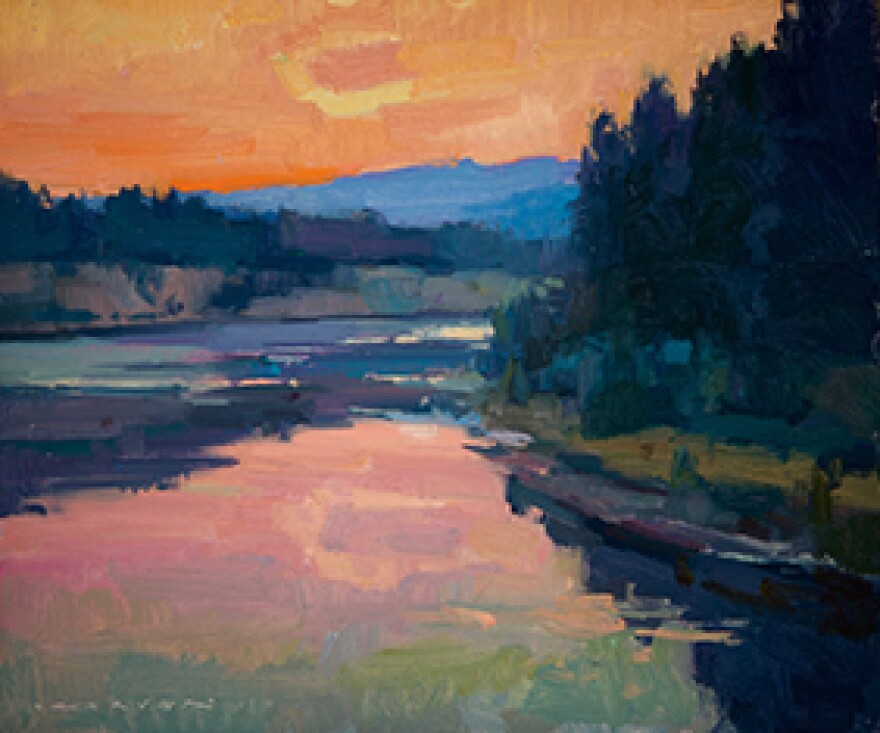Like thousands of tourists, businesses and locals, wildfire altered plans for some 40 artists participating in a residency program hosted by Kalispell’s Hockaday Museum of Art last summer.
“There's the picture of Sperry Chalet,” says Kathy Martin, director of education at the Hockaday, pointing at a painting. “This is the Sperry Chalet we all know from photographs or from personal experience. We see that there's some wildflowers blooming in the grassy meadow …”

She’s speaking at the Hockaday, at a recent talk about art, science and fire management using pieces from the museum’s Timeless Legacy exhibition to help people see the give and take fire imparts on a landscape.
Martin says this painting by Montana-born Linda Tippetts is likely one of the last captured en plein air before the Chalet’s dormitory burned in the Sprague Fire in August 2017.
“She was there the week before the Chalet burned,” Martin says. “And in fact she said she did this three days before they kicked everybody out.”
Timeless Legacy is an annual showing of American and Canadian artists’ work featuring both sides of the Glacier-Waterton International Peace Park.
“There's so much more in these paintings when you start to understand some of the ecology of fire,” says Ali Ulwelling, with the state Department of Natural Resources and Conservation. She points to a small oil painting of a black bear tromping through a stand of charred stumps. A woman in the audience said it shows the devastating effects of wildfire. But Ulwelling sees something different in Erica Neumann’s painting.
“This grizzly bear after a burn? There's fresh, there's green,” she says. “He likes that. Those trees are falling down and those logs are rotting and those ants are there and they can go feed.”

Ulwelling sees fire impacts in other paintings, too, like Jill Carver’s splashes of purple fireweed and lurid red and orange sunsets, or the muted colors and broad brush strokes Catherine Stats used to depict smokey river scenes.

Rick Connell sees fire even in paintings of lush green hillsides.
“You don't see fire in the landscape, but fire's borne of and fire maintains the landscape, the vegetation,” he says.
Connell is the fire management officer for the Flathead National Forest. He points to a large oil painting of a sweeping landscape: rusty river in the foreground, evergreen trees on the opposite bank, a clear meadow at the foot of a towering cliff face in the distance.
“In order to have a beautiful landscape, it had to start from something that probably burned in some time frame,” Connell says.
Connell has more than a century’s worth of observations and data to back this up. Landscapes naturally burn in cycles that last about as long as it takes the forest to regrow. Grasslands on the park’s east side burn frequently, maybe every 25 to 40 years. The fir and larch forests that flank the peaks of the Continental Divide burn every 150 to 200 years. The cedars and hemlock near Avalanche Lake might only see fire every 500 years.

“You can kind of look at, 'well hey, I can see where there's different patterns on the landscape,' in these pictures that are being captured and drive that home for you, and maybe not necessarily look at some of these pictures with burnt trees and think it's all catastrophic, because it's renewal,” Connell says.
Glacier National Park's Fire Management Officer Dave Soleim says the large fires Glacier has seen in the past few summers aren’t surprising when you look at historic burn patterns in the area.
“That fire return and type of fire we have there is typically stand replacement fire on a long duration between fires,” Soleim says. “And if we look at the fires that occurred last couple years, that we see as maybe devastating fire, that's kind of a typical fire pattern for our area here.”
Soleim says it’s possible to change an area’s fire regime — that’s the typical intensity, severity, size, pattern and time between burns — by changing the makeup of a forest, for example through selective logging or prescribed burning. But fire managers will never be able to knock fire off the landscape entirely.
“Wildfire has been and will continue to be the major disturbant factor on our landscape,” he says. “Plants and animals that live here have survived and adapted over the eons and continue to thrive … We need to live safely with fire and understand that it's an inevitability here.”
As the lecture wrapped up, I caught up with the woman who thought of wildfires as devastating. Her name is Annette Barkley-Rippons.
“What do you think of now?” I ask her.
“Renewal,” she says. “Total renewal. Necessary. Cycle of life. Yeah, I was really encouraged. Devastation no more.”
The Timeless Legacy exhibit runs now through December 1 at the Hockaday Museum of Art in Kalispell.




